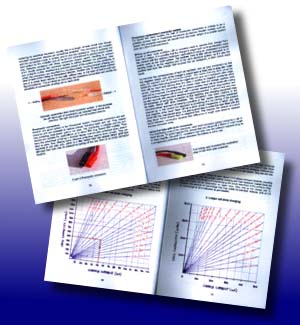

| A User Friendly Guide To Nickel Cadmium & Nickel Metal Hydride Batteries | ||
|
By
Peter Dennis
This time Andrew guides us through some of the mysteries surrounding Nickel Cadmium (NiCd) and Nickel Metal Hydride (NiMh) batteries. This book, like the earlier guide to the Super Nova Charger aims to help both newcomers and the more experienced to gain a better understanding of the equipment we all take for granted. And like the first, it's certainly 'User Friendly.' So whether you are an Electric flyer or just use rechargeable batteries in your radio gear, this book is for you. If you're anything like me, when I first started in aeromodelling and electric flying, the bewilderment of numbers, amps, cells and voltages all sent my brain in overdrive. This is where Andrew's book can help, by leading you, in simple steps, through an array of information. By the end of the book it will give you an excellent grounding in all the basics of battery usage, charging, care and safety. The book begins with some Battery Basics and some simple explanations of Voltage, Current, Resistance and Watts. All the stuff we should have learnt in our physics lessons at school, but (if you're anything like me) didn't! Cell capacities come next, along with the principles of charging and the dreaded 'C' rate. Actually it's not as scary as you might first think. As always the book explains in a friendly way, with the use of diagrams, all these basic principals. Once the basics have been dealt with Andrew moves onto the various characteristics of the NiCd and the NiMh battery. There is also an interesting calculation for the number of safe flights you can make from each charge.
Chapter 4 also covers other basic charging safety precautions and procedures. Like plugging the leads to your charger BEFORE wiring it to the battery! And once again Andrew provides a simple formula to calculate charging times. Other questions the novice electric flyer always asks is 'What connectors should I use?' Well Andrew comes to the rescue with a detailed explanation of all the types available, their good points and their bad point. Plus the correct way to wire up your batteries and charge leads. By this stage of the book you will be getting a good insight into the way your batteries are behaving. So the rest of the book now gets a little more technical. Firstly covering the physical construction of a battery, memory effect and storage. Battery checking and testing and even an explanation of 'Black Wire Syndrome' is followed by some useful maintenance advice. The book concludes with four very useful graphs mapping out charging rates and times for different capacity cells and a Test Report Car to keep a regular check on how your cells are behaving. Andrew finishes the book with his top tips for Nickel based batteries for charging, discharging and storage. As in his first book, Andrew has guided the reader through some complex issues in a very enjoy and interesting way. A complex subject has been explained simply and clearly. Each section is well illustrated with either photographs or diagrams and the book is full of useful advice and tips. Simple calculation are spread through out the book so that you can check for your self exactly how your batteries work and how to maintain them. I can guarantee that after reading these forty-four pages that you will have a firm understanding of all the principals involved. Whether you only use batteries in your radio gear or as a power supply for electric flight, the greater understanding gained from this book will only enhance your enjoyment of aeromodelling. 'A
User-Friendly Guide to Nickel Cadmium & Nickel Metal Hydride
Batteries'
Andrew Gibbs Price £6.75 (inc p+p) Cheques made payable to Andrew Gibbs. Email: mrandrewgibbs@yahoo.com Also available from some model shops including Sussex Model Centre. Please
mention 'Flying Sites'
when contacting Andrew
|
 Following
on from his success with his User Friendly Guide to the Super Nova
Charger, (
Following
on from his success with his User Friendly Guide to the Super Nova
Charger, ( One
of the great mysteries in battery technology is how long and at
what current should you charge your batteries! Well if you get it
wrong you could end up with a mess at the very least and serious
damage to you and your property at the worst. The photograph in
chapter 4 should be warning enough!
One
of the great mysteries in battery technology is how long and at
what current should you charge your batteries! Well if you get it
wrong you could end up with a mess at the very least and serious
damage to you and your property at the worst. The photograph in
chapter 4 should be warning enough!